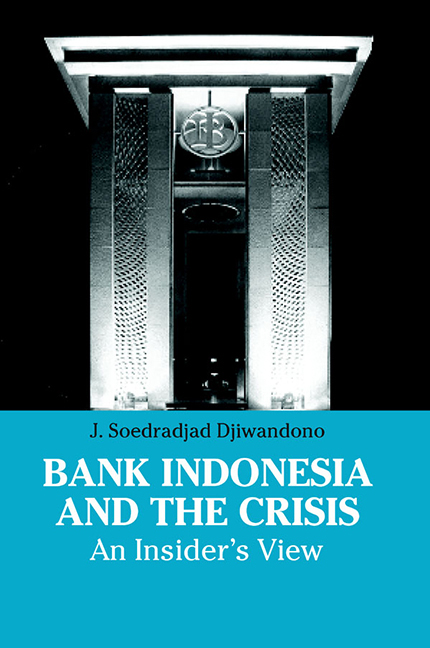Book contents
- Frontmatter
- Dedication
- Contents
- List of Tables
- Acknowledgements
- Glossary
- Prologue: The Crisis and Me
- 1 Introduction
- 2 Origin of the Crisis and Early Responses
- 3 Stabilization and Reform Programmes
- 4 Poor Programme Implementation
- 5 Stronger Programme with Weak Commitment
- 6 Bank Indonesia and the Crisis
- 7 Lessons from the Crisis
- 8 Epilogue
- Postscript
- Notes
- References
- Index
- About the Author
1 - Introduction
Published online by Cambridge University Press: 21 October 2015
- Frontmatter
- Dedication
- Contents
- List of Tables
- Acknowledgements
- Glossary
- Prologue: The Crisis and Me
- 1 Introduction
- 2 Origin of the Crisis and Early Responses
- 3 Stabilization and Reform Programmes
- 4 Poor Programme Implementation
- 5 Stronger Programme with Weak Commitment
- 6 Bank Indonesia and the Crisis
- 7 Lessons from the Crisis
- 8 Epilogue
- Postscript
- Notes
- References
- Index
- About the Author
Summary
The idea of writing an assessment and analysis of what had been developing in Indonesia's economics and finance had been with me for some time. It started around the middle of my five-year term as Governor of Bank Indonesia, when the Bank commissioned a team to write a history (Rahardjo 1995). The idea was to write about my experience as well as assessment of the management of the national economy, as viewed from the Indonesian central bank.
Due to the crisis that struck Indonesia in early July 1997, I decided to work on the Indonesian crisis first. With my dismissal, I wanted to write about what I had observed, analysed, and decided during the crisis in my capacity as one of the key Indonesian economic policymakers. I told President Soeharto about this plan during my last meeting with him at his residence.
I ultimately wrote a book, Mengelola Bank Indonesia dalam Masa Krisis (Managing Bank Indonesia during the Crisis) and Bergulat dengan Krisis dan Pemulihannya (Fighting the Crisis and Its Recovery). Both were written in Bahasa Indonesia, and were published in October 2001. The present book is a revised English version of the first book.
The Indonesian crisis as a part of the Asian crisis has been analysed and reported on extensively. It has also been widely discussed at many conferences and seminars. Many have argued that the Asian financial crisis was the worst since the Second World War. Meanwhile, the Indonesian crisis has been portrayed as the worst case in the Asian crisis as measured in terms of different economic and social indicators and the depth and spread of its negative impacts.
The Indonesian crisis originated from an external shock in the foreign exchange market that contagiously caused a drastic depreciation of the rupiah, then became a total crisis. The shock in the foreign exchange market that originated from the Thai baht crisis produced a chain of effects that exposed structural weaknesses in Indonesia's economy, and its socio-political fabric, which were hitherto hidden by high economic growth.
- Type
- Chapter
- Information
- Bank Indonesia and the CrisisAn Insider's View, pp. 13 - 21Publisher: ISEAS–Yusof Ishak InstitutePrint publication year: 2005

